How to Launch CMD, check System Hardware and Software Specification.
4th Jan 2017 | category: Computer & Printers | Hits: 1015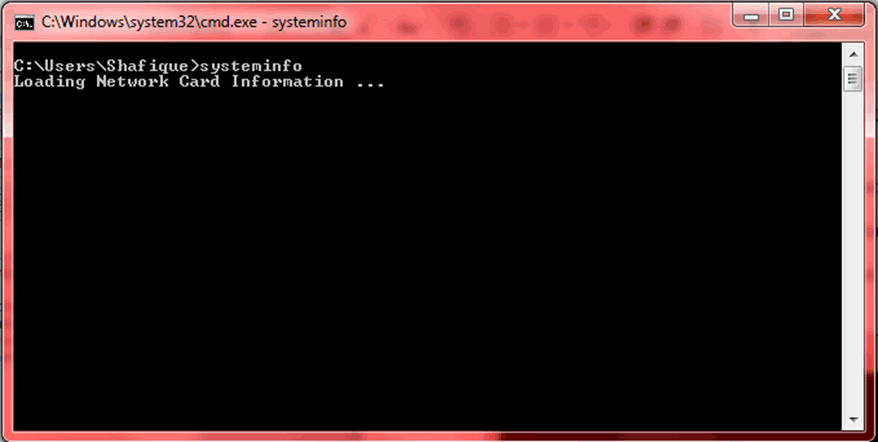
What is CMD?,
Basically CMD stands for Command, CMD is the interface which was used in the early ages of the computer revolution before a Graphical User Interface was invented by Apple .Inc on a Macintosh Computer. The graphical User Interface was later adopted by the PC or Windows computer later on. The CMD interface or window is normally a black screen with lines and it operates with commands issued by the user through keyboard input.
To launch the command line on a windows 7 or later version, Press the Windows Key, Type “CMD”, (without the quotes) and hit the return or Enter key on the Keyboard.
A window like the one below will be launched and you will be able to proceed with checking for system software and hardware specification.
To check for system software and hardware, Type “systeminfo” in the command line and press the Enter on your keyboard.
The commandline will load both the hardware and software specification of the machine or computer on which you will be running the command.
On completion of loading the command issued, the screen will be filled with multiple text.
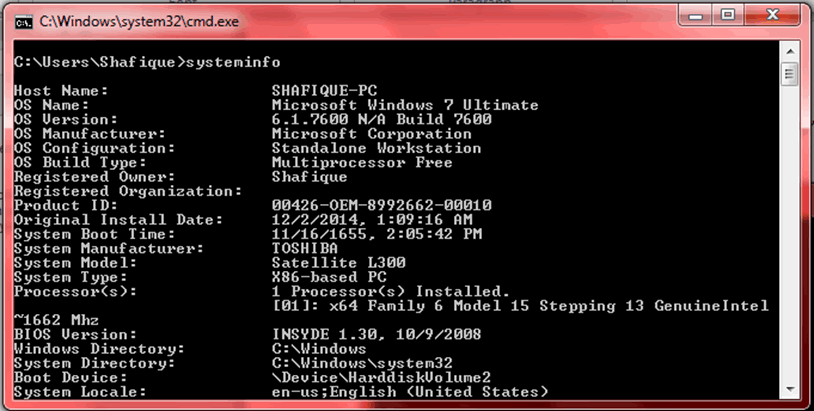 Type "System Info"
Type "System Info"
C:\Users\Shafique>systeminfo
Host Name: SHAFIQUE-PC (This represents the name of the system, normally entered sring installation of the Operating System)
OS Name: Microsoft Windows 7 Ultimate (This is the name and Edition of the Operating system of the computer on which the command is issued)
OS Version: 6.1.7600 N/A Build 7600 (this represents the version of the Operating system)
OS Manufacturer: Microsoft Corporation (Operating system manufacturer)
OS Configuration: Standalone Workstation
OS Build Type: Multiprocessor Free
Registered Owner: Shafique
Registered Organization:
Product ID: 00426-OEM-8992662-00010
Original Install Date: 12/2/2014, 1:09:16 AM
System Boot Time: 11/16/1655, 2:05:42 PM
System Manufacturer: TOSHIBA
System Model: Satellite L300
System Type: X86-based PC
Processor(s): 1 Processor(s) Installed. [01]: x64 Family 6 Model 15 Stepping 13
GenuineIntel ~1662 Mhz
BIOS Version: INSYDE 1.30, 10/9/2008
Windows Directory: C:\Windows
System Directory: C:\Windows\system32
Boot Device: \Device\HarddiskVolume2
System Locale: en-us;English (United States)
Input Locale: en-us;English (United States)
Time Zone: (UTC+03:00) Nairobi
Total Physical Memory: 1,916 MB
Available Physical Memory: 252 MB
Virtual Memory: Max Size: 3,855 MB
Virtual Memory: Available: 1,249 MB
Virtual Memory: In Use: 2,606 MB (this figure represents the RAM the computer has)
Page File Location(s): C:\pagefile.sys (this is the path to the file in which system state is saved whenever the computer is put in sleep mode or Hibernated)
Domain: WORKGROUP
Logon Server: \\SHAFIQUE-PC
Hotfix(s): 1 Hotfix(s) Installed. [01]: KB958488
Network Card(s): 2 NIC(s) Installed. : Realtek RTL8102E/RTL8103E Family PCI-E Fast Ethernet NIC (NDIS 6.20)
Connection Name: Local Area Connection
Status: Media disconnected
[02]: Realtek RTL8187B Wireless 802.11b/g 54Mbps USB
2.0 Network Adapter
Connection Name: Wireless Network Connection
Status: Media disconnected
How to use CMD to for checking disk capacity and fixing volume errors
Launch the elevated commandline as described in the previous How to article,
Type diskpart and hit the return or enter key
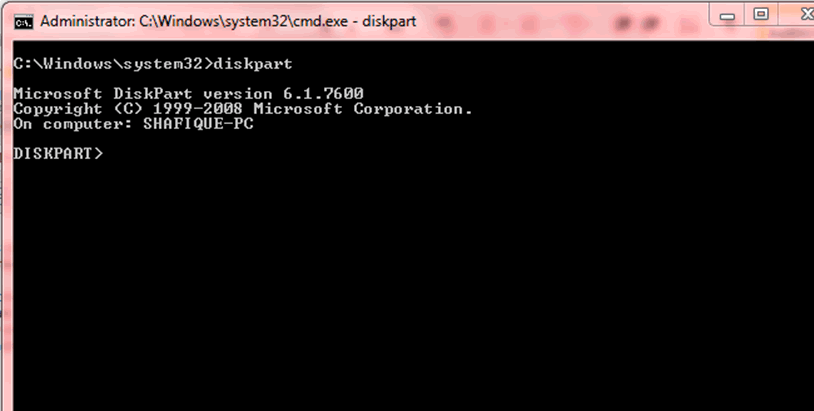 Type diskpart
Type diskpart
Next, type list disk and hit the return or enter key on your keyboard
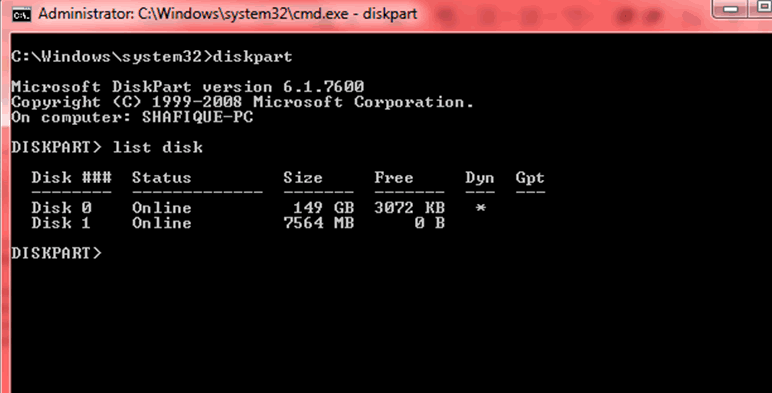 Type diskpart
Type diskpart
Disk 0 is the combined internal HDD in the computer having 149 GB and Disk 1 is the recovery of reserved partition of the physical HDD, it is normally not shown among the system drive partition as it is a system reserved partition and its automatically created at the time of installing the Operating System. The total capacity of the HDD in the computer on which the command were run is 150GB after adding the system reserved memory.
To check computer drives for Errors and fix them using CMD
Launch CMD as described in the previous how to article, or to launch cmd faster, press and hold down the Windows Key, then Press the R key on your keyboard, then type CMD in the small Run window and hit the enter key on your keyboard.
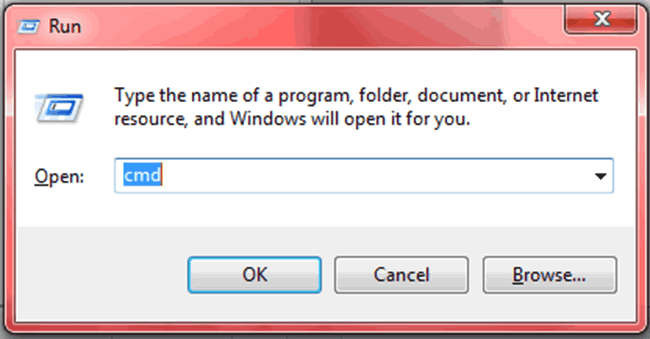 Type chkdsk D: /r /f
Type chkdsk D: /r /f
Type chkdsk D: /r /f
The above command will check the driver or partition labeled D, repair and fix any error found.
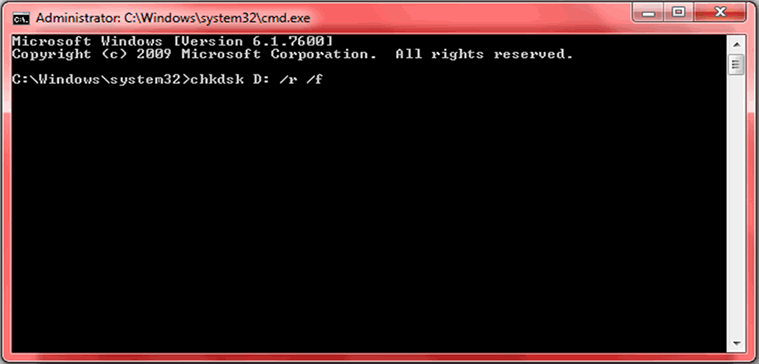 Chkdsk Screenshot
Chkdsk Screenshot
This may take several minutes depending on the capacity of data on the drive and the size of the drive being checked.
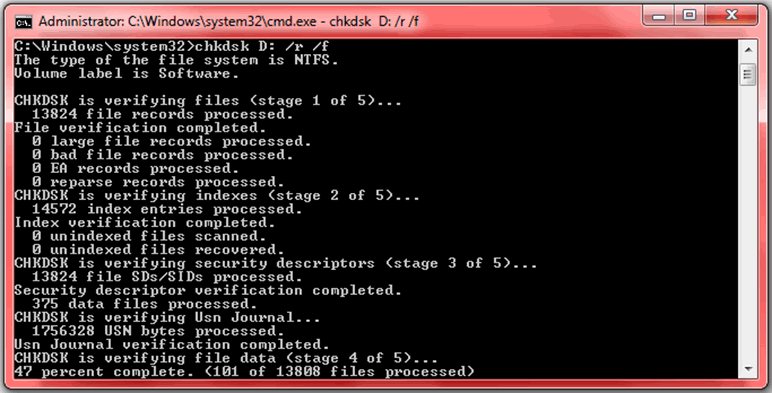 hardware and software specification of the machine or computer on which you will be running the command.
hardware and software specification of the machine or computer on which you will be running the command.
hardware and software specification of the machine or computer on which you will be running the command.